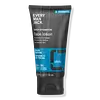What's inside
What's inside
 Key Ingredients
Key Ingredients

 Benefits
Benefits

 Concerns
Concerns

 Ingredients Side-by-side
Ingredients Side-by-side

Water
Skin ConditioningCaprylic/Capric Triglyceride
MaskingPropanediol
SolventCetyl Alcohol
EmollientSilica
AbrasiveCetearyl Olivate
Sorbitan Olivate
EmulsifyingNiacinamide
SmoothingOlea Europaea Fruit Oil
MaskingGlyceryl Stearate
EmollientSodium Hyaluronate
HumectantAloe Barbadensis Leaf Juice
Skin ConditioningHelianthus Annuus Seed Oil
EmollientRosmarinus Officinalis Leaf Extract
AntimicrobialDisodium Cetearyl Sulfosuccinate
CleansingSodium Gluconate
Skin ConditioningEthylhexylglycerin
Skin ConditioningMethylheptylglycerin
HumectantCitric Acid
BufferingXanthan Gum
EmulsifyingPhenoxyethanol
PreservativeWater, Caprylic/Capric Triglyceride, Propanediol, Cetyl Alcohol, Silica, Cetearyl Olivate, Sorbitan Olivate, Niacinamide, Olea Europaea Fruit Oil, Glyceryl Stearate, Sodium Hyaluronate, Aloe Barbadensis Leaf Juice, Helianthus Annuus Seed Oil, Rosmarinus Officinalis Leaf Extract, Disodium Cetearyl Sulfosuccinate, Sodium Gluconate, Ethylhexylglycerin, Methylheptylglycerin, Citric Acid, Xanthan Gum, Phenoxyethanol
Water
Skin ConditioningGlycerin
HumectantCaprylic/Capric Triglyceride
MaskingCannabis Sativa Seed Oil
EmollientOleyl Erucate
EmollientNiacinamide
SmoothingZinc PCA
HumectantHydrolyzed Pea Protein
EmollientGlucose
HumectantSodium Chloride
MaskingSodium Succinate
BufferingAmmonium Acryloyldimethyltaurate/Vp Copolymer
Acrylates/C10-30 Alkyl Acrylate Crosspolymer
Emulsion StabilisingOenothera Biennis Oil
EmollientSqualane
EmollientAchillea Millefolium Flower Extract
AntioxidantEthylhexylglycerin
Skin ConditioningNeopentyl Glycol Diheptanoate
EmollientTocopheryl Acetate
AntioxidantPhenoxyethanol
PreservativeSodium Phytate
Sodium Hydroxide
BufferingWater, Glycerin, Caprylic/Capric Triglyceride, Cannabis Sativa Seed Oil, Oleyl Erucate, Niacinamide, Zinc PCA, Hydrolyzed Pea Protein, Glucose, Sodium Chloride, Sodium Succinate, Ammonium Acryloyldimethyltaurate/Vp Copolymer, Acrylates/C10-30 Alkyl Acrylate Crosspolymer, Oenothera Biennis Oil, Squalane, Achillea Millefolium Flower Extract, Ethylhexylglycerin, Neopentyl Glycol Diheptanoate, Tocopheryl Acetate, Phenoxyethanol, Sodium Phytate, Sodium Hydroxide
 Reviews
Reviews

Ingredients Explained
These ingredients are found in both products.
Ingredients higher up in an ingredient list are typically present in a larger amount.
This ingredient is an emollient, solvent, and texture enhancer. It is considered a skin-softener by helping the skin prevent moisture loss.
It helps thicken a product's formula and makes it easier to spread by dissolving clumping compounds.
Caprylic Triglyceride is made by combining glycerin with coconut oil, forming a clear liquid.
While there is an assumption Caprylic Triglyceride can clog pores due to it being derived from coconut oil, there is no research supporting this.
Learn more about Caprylic/Capric TriglycerideEthylhexylglycerin (we can't pronounce this either) is commonly used as a preservative and skin softener. It is derived from glyceryl.
You might see Ethylhexylglycerin often paired with other preservatives such as phenoxyethanol. Ethylhexylglycerin has been found to increase the effectiveness of these other preservatives.
Niacinamide is a multitasking form of vitamin B3 that strengthens the skin barrier, reduces pores and dark spots, regulates oil, and improves signs of aging.
And the best part? It's gentle and well-tolerated by most skin types, including sensitive and reactive skin.
You might have heard of "niacin flush", or the reddening of skin that causes itchiness. Niacinamide has not been found to cause this.
In very rare cases, some individuals may not be able to tolerate niacinamide at all or experience an allergic reaction to it.
If you are experiencing flaking, irritation, and dryness with this ingredient, be sure to double check all your products as this ingredient can be found in all categories of skincare.
When incorporating niacinamide into your routine, look out for concentration amounts. Typically, 5% niacinamide provides benefits such as fading dark spots. However, if you have sensitive skin, it is better to begin with a smaller concentration.
When you apply niacinamide to your skin, your body converts it into nicotinamide adenine dinucleotide (NAD). NAD is an essential coenzyme that is already found in your cells as "fuel" and powers countless biological processes.
In your skin, NAD helps repair cell damage, produce new healthy cells, support collagen production, strengthen the skin barrier, and fight environmental stressors (like UV and pollution).
Our natural NAD levels start to decline with age, leading to slower skin repair, visible aging, and a weaker skin barrier. By providing your skin niacinamide, you're recharging your skin's NAD levels. This leads to stronger, healthier, and younger looking skin.
Another name for vitamin B3 is nicotinamide. This vitamin is water-soluble and our bodies don't store it. We obtain Vitamin B3 from either food or skincare. Meat, fish, wheat, yeast, and leafy greens contain vitamin B3.
The type of niacinamide used in skincare is synthetically created.
Learn more about NiacinamidePhenoxyethanol is a preservative that has germicide, antimicrobial, and aromatic properties. Studies show that phenoxyethanol can prevent microbial growth. By itself, it has a scent that is similar to that of a rose.
It's often used in formulations along with Caprylyl Glycol to preserve the shelf life of products.
Water. It's the most common cosmetic ingredient of all. You'll usually see it at the top of ingredient lists, meaning that it makes up the largest part of the product.
So why is it so popular? Water most often acts as a solvent - this means that it helps dissolve other ingredients into the formulation.
You'll also recognize water as that liquid we all need to stay alive. If you see this, drink a glass of water. Stay hydrated!
Learn more about Water